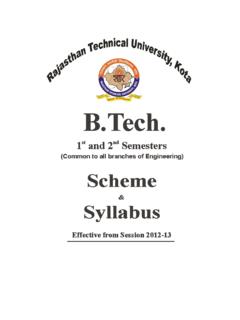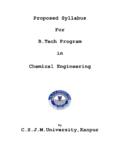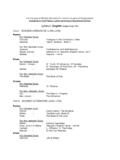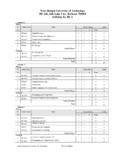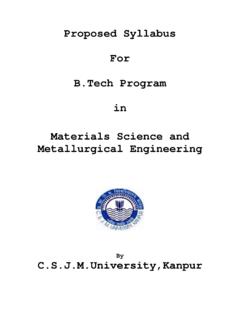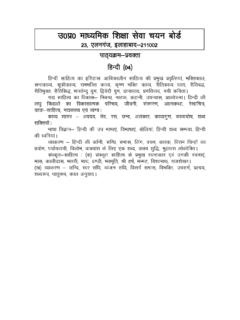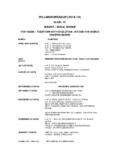Transcription of B.Tech. Syllabus (ALL) - jntucekcs.org
1 (Computer science and Engineering) Ist Year Effective from 1999-2000. COURSE STRUCTURE Subject Subject T P C Code CS1001 english 3 - 6 CS1002 Mathematics I 3+1* - 6 CS1003 Applied Physics 2+1* - 6 CS1004 Computers and Information Technology 3 - 6 CS1005 C & Data Structures 3 - 6 CS1006 Network Theory 3.
2 6 CS1007 Semiconductor Devices and circuits 3 - 6 CS1008 Engineering Drawing Practice - 3 4 CS1009 Computer Programming Lab - 6 8 CS1010 Semiconductor Devices and Circuits Lab - 3 4 20+2* 12 56 * Tutorial. CS1001 english (Common for all Branches) UNIT-I From A Text book of english for Engineers and Technologists ( ) 1. Energy, Unit 3: Alternative sources 2. Computers, Unit 2: New Frontiers. UNIT-II From A text book of english for Engineers and Technologists ( ) 1.
3 Technology Unit 3: Evaluating Technology 2. Environment, Unit 2: Pollution. UNIT-III From A text book of english for Engineers and Technologists ( ). 1. Industry, unit 2: Safety and training. From masterminds ( ) 2. The trailblazers. UNIT-IV From Masterminds ( ) 1. The word of figures and Physics 2. The Institution of Builders. UNIT-V From Masterminds ( ) 1. The new age 2. The Living world. UNIT-VI Correction of sentences, sentence completion, Analogy, Report writing, Flowcharts and Pie Charts, General Essay, Comprehension, Sounds of english , Accent and Intonation. BOOKS RECOMMENDED: 1. Strengthen your writing by V. R. Narayana Swamy ( ). 2. Success with grammar and composition by K. R. Narayanaswamy ( ). 3. Examine your english by Margaret M. Maison ( ). 4.
4 english for Professional Students by S. S. Prabhakara Rao 5. TOEFL (ARCO & BARRONS, USA). 6. GRE (AARCO & BARRONS, USA). CS1002 MATHEMATICS - I (Common for all Branches). UNIT I Sequences Series Convergence and divergence Ratio test Comparison test Integral test Cauchy s root test Rabe s test Absolute and conditional convergence. UNIT II Rolle s theorem Mean value theorem Lagrange s and Cauchy s form with remainders Radius, Centre and Circle of curvatures Evolutes and envelopes. UNIT III Functions of several variables Partial differentiation chain rule Euler s theorem Jacobian Functional dependence Taylor s theorem - Maxima and Minima of functions of two variables with and without constraints. Curve tracing Cartesian, Parametric and Polar coordinates.
5 UNIT IV Application of integration to lengths, volumes and surface areas Cartesian and Polar coordinates Double and triple integrals, change of variables changing the order of integration differential equations of first order and first degree Exact, Linear and Bernoulli equation. Applications to Geometry, Law of natural growth and Newton s Law of Cooling. UNIT V Linear differential equations of second and higher order with constant coeffients Homogenous simultaneous equations Method of variation of parameters. Laplace transform of standard functions Inverse transforms convolution theorem without proof Transforms of periodic functions of derivative and integrals Applications of to ordinary differential equations. UNIT VI Gradients, divergence, curl and their related properties, Line, surface, volume integrals potential function workdone as line integral curvilinear coordinates cylindrical and spherical coordinates Expressions of Grad, Div, Curl, Spherical, Cylindrical and Polar coordinates Green s stokes and divergence theorems (with proofs) and some simple problems.
6 TEXT BOOKS: 1. Advanced Engineering Mathematics by Kreyszig. E 2. Higher Engineering Mathematics by B. S. Grewal. 3. Engineering Mathematics by Lazpathroy. CS1003 APPLIED PHYSICS (Common for EEE, ECE, EIE, EcontE, CSE, CSIT & BME) UNIT-I Chapter 1: Free electron gas model; free electron gas in one dimensional box; energy levels and density of states; Thermionic emission; Schottky emission; Field emission; and photo electric emission; Hall effect. Chapter 2: Periodic lattice and Bloch s theorem; Kronig Penny model; velocity effective mass; distinction between metals, insulators and semiconductors; Density of states. UNIT II Chapter 3: Dieelectrics; Local field; Clausius Mossoti equation; sources of polarizability (dipolar, iornic & electronic) frequency dependence; total polarizability; measurement of dielectric constant; piezoelectricity; ferroelectricity.
7 Chapter 4: Magnetic materials: diamagnetism; classical theory quantum theory (Qualitative); paramagnetism; classical theory Quantum theory (Qualitative); cooling by adiabatic demagnetization; ferromagnetism; Weiss theory; Hysteresis; domains; Bloch wall; antiferromagnetism molecular field theory; ferromagnetism molecular field theory; ferrimagnetism molecular field theory. UNIT III Chapter 5: Fermi Dirac statistics; electron and hold densities; overall perspective; intrinsic semiconductors; charge neutrality; recombination; Schockley, Read and hall Theory; surface recombination and emission. Chapter 6: Semiconductors; nonequilibrium; continuity equation ; carrier scattering and mobility; drift current and conductivity; diffusion currents and Einstein s relations; Quasi Fermi level; Band diagram in equilibrium and non-equilibrium.
8 Chapter 7: Thermistors and piezo resistors, phosphorescence and fluorescence; Gunn effect, Hall effect, and Thermoelectric effect. UNIT-IV Chapter 8: Radiative transitions LEDs; semiconductor laser and its characteristics. UNIT-V Chapter 9: Photoconductors; photodiodes; avalanche photodiode; phototransistor. Chapter 10: Solar radiation and conversion efficiency; PN junction; solar cells Heterojunction, interface, and thin film solar cells. UNIT VI Chapter 11: Super conductivity; experimental facts and theoretical explanations. Chapter 12: IC fabrication planar processes Fabrication of BJT, FET & CMOS devices monolithic diodes contacts IC resistors and capacitors IC packaging Characteristics of IC components. TEXT BOOKS: 1. Solid state physics by Singhal, Kedarnath Ramnath & Co.
9 , Meerut (for chapter 1 to 4 & 11). 2. Semiconductor Devices by , TMH Publications, (for chapter 5,6,& 7) 3. Physics of semiconductor devices, by Sze, Wiley Eastern (for chapter 8,9,10). 4. Micro electronics by millman & Grabel (for chapter 12). REFERENCE BOOKS: 1. Solid state physics, by Charles Kittel, 7th edition. 2. Solid state physics by A. J. Dekker 3. Physics of semiconductor Devices by M. Shur, PHI Publication. 4. Physics of semiconductor devices, by D. K. Roy, Orient Longman. 5. Introduction to solids Azaroff, TMH Edition. CS1004 COMPUTERS AND INFORMATION TECHNOLOGY (Common for ECE,EEE,EIE, E Cont E, BME, CSE & CSIT) UNIT I (Qualitative Treatment Only) Computers, capabilities, types of computers, application areas, computer anatomy, functional block diagram, central processing unit, functions of ALU and control unit in CPU, purpose of registers in CPU, microprocessors, CISC/RISC processors, memory functions, address, word, RAM, ROM, Cache memory, associate memory, magnetic disk, tape, floppy, optical disk, address bus, data bus, control bus, functions of I_O Devices, keyboard, mouse, light pen, dot-matrix printer, line printer, laser printer, ink-jet printer, CRT Monitor, color monitor, CGA, Screen resolution, flat panel display unit, machine language, assembler, high-level language, compiler, operating system, types of operating systems, number systems, binary, Hex, Octal, BCD code, character codes.
10 3 methods of binary representation of integers, floating point numbers. UNIT II (Qualitative treatment Only) Internet and World Wide Web, information technology today, word processing and desk top publishing, spread-sheet and data base applications, communications electronic web. UNIT-III (Qualitative treatment onlY) Multimedia, IT in business, programming and systems development, personal, social and ethical issues. UNIT-IV Numerical Methods I Iterative methods, bisection, false position, Newton-Raphson, successive approximation method, algorithms comparison of iterative methods, solution of linear simultaneous algebraic equations, Gauss Jordan and Gauss Siedal s methods, algorithms. UNIT V Numerical Method II Interpolation, Lagrange interpolation, forward difference, backward difference and central difference interpolation methods, algorithms, errors in interpolation, least square approximation of functions, linear regression, polynomial regression, algorithms.
